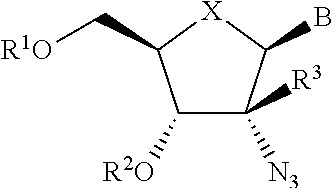2′-azido substituted nucleoside derivatives and methods of use thereof for the treatment of viral diseases
a technology of nucleoside derivatives and azido, which is applied in the field of 2′azido substituted nucleoside derivatives, can solve the problems of unfavorable side effects, poor efficacy, and serious progressive liver disease of infected individuals, and achieve the effect of treating or preventing hcv infection, and preventing hcv infection
- Summary
- Abstract
- Description
- Claims
- Application Information
AI Technical Summary
Benefits of technology
Problems solved by technology
Method used
Image
Examples
example 1
Preparation of Intermediate Compound Int-1c
[0320]
[0321]Compound Int-1a (733 mg, 1.33 mmol) was taken up in ethanol (10 mL) and the resulting suspension was heated to 80° C. and allowed to stir at this temperature for 5 minutes. Compound Int-1b (236 mg, 1.33 mmol) was then added and the resulting reaction was allowed to stir at 80° C. for an additional 2 hours. The reaction was then cooled to room temperature using in an ice bath and the reaction mixture was filtered. The collected red solid was dried under vacuum to provide compound Int-1c (579 mg, 72%).
example 2
Preparation of Intermediate Compound Int-2b
[0322]
[0323]p-Toluenesulfonyl chloride (Int-2a, 46 g, 241 mmol) was suspended in acetone (350 mL) and water (350 mL) and cooled in an ice bath to 0° C. Sodium azide (47.1 g, 724 mmol) was added in portions over 15 minutes and the resulting reaction was allowed to stir for about 15 hours at room temperature. The reaction was diluted with water and ethyl acetate and the collected organic phase was washed with water, dried over sodium sulfate, filtered and concentrated in vacuo to provide compound Int-2b (47%), which was used without further purification.
example 3
Preparation of Intermediate Compound Int-3e
[0324]
Step A—Synthesis of Compound Int-3b
[0325]Cytidine (Int-3a, 8.0 g, 32.89 mmol) was azeotroped with pyridine (2×15 mL) and then suspended in pyridine (25 mL). Tetraisopropyldisiloxanedichloride (12.0 mL, 35.4 mmol) was added dropwise over fifteen minutes and the reaction was allowed to stir for about 15 hours at room temperature. The reaction was diluted with water and extracted with ethyl acetate. The organic layers were washed with brine, dried over sodium sulfate, filtered and concentrated in vacuo. The residue was triturated with heptane to provide 13.5 g of compound Int-3b as a white solid [M+H]=486.5.
Step B—Synthesis of Compound Int-3c
[0326]Compound Int-3b (13.5 mmol, 27.8 mmol) was dissolved in ethanol (200 mL) and to the resulting solution was added acetic anhydride (10 mL). The resulting reaction was heated to 65° C. and allowed to stir at this temperature for 3 hours. The reaction mixture was concentrated in vacuo and the resu...
PUM
| Property | Measurement | Unit |
|---|---|---|
| temperature | aaaaa | aaaaa |
| temperature | aaaaa | aaaaa |
| temperature | aaaaa | aaaaa |
Abstract
Description
Claims
Application Information
 Login to View More
Login to View More - R&D
- Intellectual Property
- Life Sciences
- Materials
- Tech Scout
- Unparalleled Data Quality
- Higher Quality Content
- 60% Fewer Hallucinations
Browse by: Latest US Patents, China's latest patents, Technical Efficacy Thesaurus, Application Domain, Technology Topic, Popular Technical Reports.
© 2025 PatSnap. All rights reserved.Legal|Privacy policy|Modern Slavery Act Transparency Statement|Sitemap|About US| Contact US: help@patsnap.com



